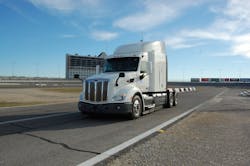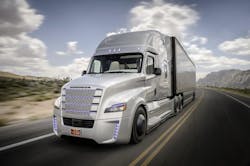How can self-driving trucks save fleets money while potentially opening up new avenues of profit as well? Answering those questions successfully may be the key to making autonomous vehicles (AVs) a reality in the commercial truck world.
“It’s a challenge to capture the true return on investment (ROI) offered by autonomous trucks,” Michael Rofman, senior manager at consulting and tax advisory firm WeiserMazars LLP, explained to Fleet Owner.
But one of the biggest cost benefits he believes is offered by “self-driving” trucks centers on a reduction in accidents, which for fleets means a reduction in claims and insurance premiums.
Mark Rosekind, head of the National Highway Traffic Safety Administration (NHTSA), touched on that very point in a speech last month in which he noted that in 94% of fatal crashes, according to his agency’s data, a “human mistake” is the “critical factor” triggering it.
Rosekind also firmly believes AVs offer the potential to be the “biggest revolution” ever in vehicle technology and will play a pivotal role in avoiding a good many fatal crashes altogether.
Yet it’s a revolution he thinks still remains a long way off. “It will take 20 to 30 years for self-driving cars to fully penetrate the [vehicle] market,” Rosekind explained, though the U.S. Department of Transportation (DOT) is planning to invest $4 billion over the next 10 years to help spur more AV research and development.
“We can’t just make such technology appear in cars by tomorrow,” he said. “[But] it is not science fiction to suggest that technology could sometime, in the not-too-distant future, help us avoid the vast majority of fatal crashes.”
WeiserMazars' Rofman thinks the trucking industry can “reasonably expect” to see autonomous trucks on the road by the year 2035, though the advent of such vehicles won’t lessen the need for drivers.
“We’ve had autopilot in airplanes for 25 to 30 years now, but we still have two pilots in the plane,” he said. “So autonomous trucks won’t be completely free from humans.”
Rofman envisions autonomous trucks will operate themselves on the highways, perhaps in designated “fThe profit-making potential for fleets in this set-up, to his mind, centers around freeing up the driver’s time perform more “administrative tasks” such as route planning and freight booking, will monitoring vehicle performance more directly to ensure greater uptime.
“Future truck drivers will be known as commercial vehicle operators (CVO) because their job will increasingly encompass more than driving a truck as new technology enters the industry,” Rofman emphasized. “CVOs will equally be system managers and monitors. Trucking companies and CVOs will need to evolve as new technology and management systems reshape the skill sets necessary to operate a truck.”
But in the opinion several experts, insurance savings will be the key to making AVs acceptable in trucking.
“Insurance is the key and will be watched closely,” Dan Murray, VP of research for the American Trucking Research Institute (ATRI) during a meeting last December on automated trucks. “The economics are huge in this area. So if AV technology offers a demonstrable safety benefit, the insurance industry will champion it. But if it does not, they will be very hesitant.”
“Fewer accidents mean fewer claims and that ripples down the rating structure,” noted David Golden, Asst. VP-commercial lines policy for the Property Casualty Insurers Association of America (PCIAA) at that same meeting.
“Insurance pricing is all about data,” he added. “How might the use of autonomous trucks change that? We don’t know because we don’t have any data. In one year we’ll have a small data set; by five years a big one. And by 10 years we’ll have a very big data set with good experience.” That’s why Golden believes the “speed of adoption” of AV technology may be key to its overall cost savings potential for trucking.
About the Author
Sean Kilcarr
Editor in Chief
Sean Kilcarr is a former longtime FleetOwner senior editor who wrote for the publication from 2000 to 2018. He served as editor-in-chief from 2017 to 2018.

